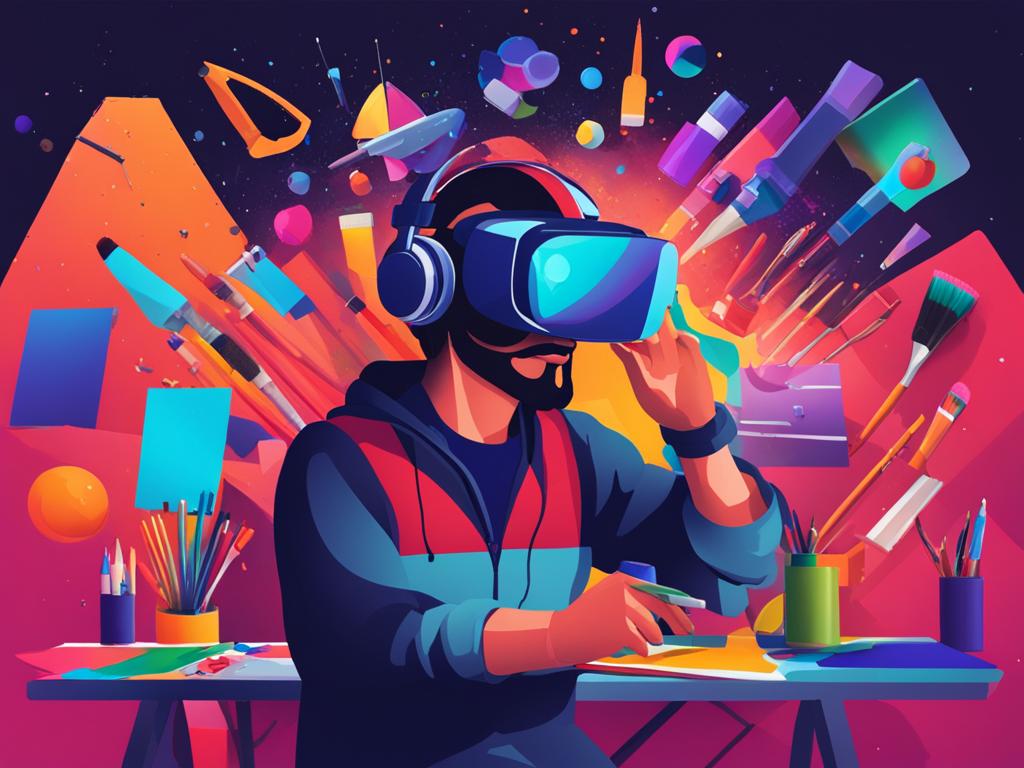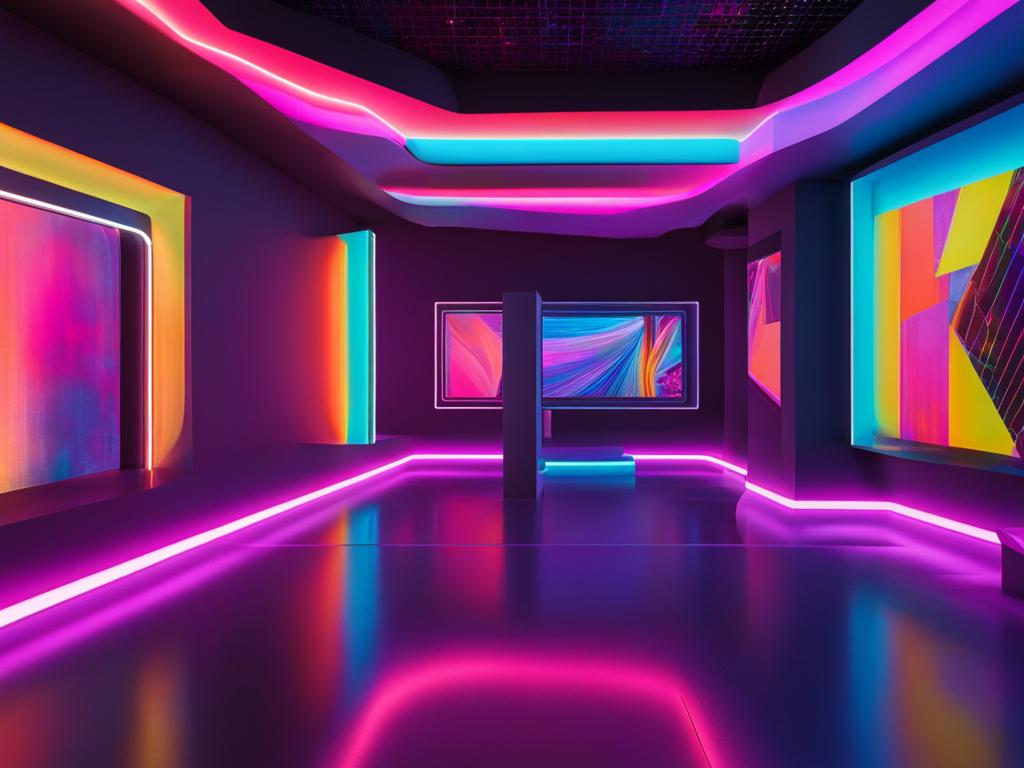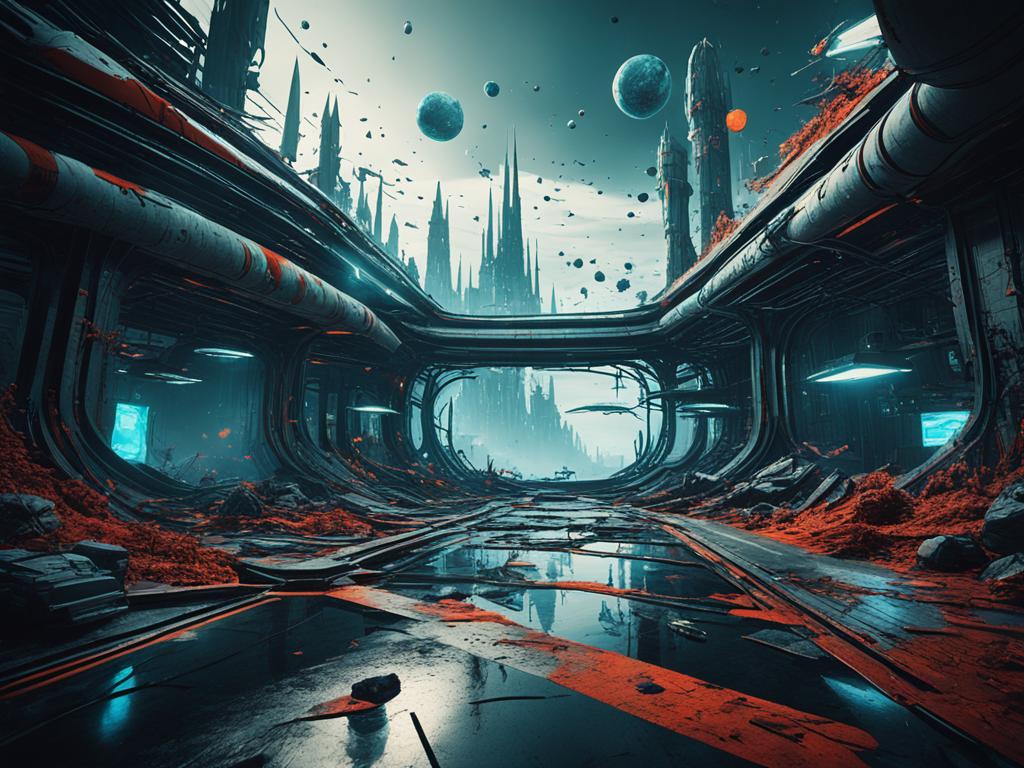As an artist, I am always looking for new ways to enhance my creativity and explore different mediums. That’s why I’m excited to share with you the world of virtual reality art programs. Virtual reality art program is a revolutionary technology that has the potential to transform the art world as we know it. It offers an immersive and transformative experience for both the artist and the viewer. By using digital tools, artists can create unique and interactive artworks that engage the viewer on a new level. In this article, I will explore the evolution of virtual reality art, the techniques used, the impact on the art world, and much more. So, let’s dive into the exciting world of virtual reality art programs and discover how they can help us develop our creative skills.

Evolution of Virtual Reality Art
The use of virtual reality technology has revolutionized the way artwork is created and experienced. Virtual reality art, also known as VR art, brings together the world of digital art and the immersive experience of virtual reality. The first VR art program was developed in the 1990s, but it wasn’t until the 2010s that VR art gained widespread popularity.
Virtual reality art programs have since evolved to become more user-friendly and accessible to artists. These programs provide endless possibilities for artists to create new and innovative art forms that challenge traditional artistic mediums. Artists can manipulate digital tools and create unique and immersive experiences through VR art programs, allowing for the creation of interactive installations and performances.
“Virtual reality and its corollary, augmented reality, will become powerful intermediaries in how we shape and experience art and culture.” – Chris Milk
The evolution of virtual reality art has led to the emergence of virtual art programs that cater specifically to the needs of artists. These virtual art programs provide a platform for artists to showcase their work and connect with other artists from around the world. In addition to this, virtual reality programs have also enabled artists to collaborate in new and innovative ways, bringing together diverse artistic practices and styles.
As the technology continues to evolve, the potential for virtual reality art will only continue to grow. The integration of VR technology into the mainstream art world has opened up new possibilities for artistic expression and has challenged traditional notions of art galleries and exhibitions.
VR art programs and virtual art programs have transformed the artistic landscape, providing a new dimension to the traditional mediums of painting, drawing, and sculpture. The intersection of technology and art has enabled artists to push the boundaries of creativity and create immersive installations that engage audiences on a new level. As technology continues to advance, the possibilities for virtual reality art are endless, making it an exciting time to be a virtual reality artist.
Techniques in Virtual Reality Art
Virtual reality art is a rapidly-evolving field that offers endless creative possibilities. Through VR art programs, artists can explore various techniques to create unique and immersive experiences for the viewer.
“Virtual reality is really the first technology that can really give you the sense that you are inside the art.”
One popular technique in virtual reality art is sculpting, which allows artists to shape and mold three-dimensional objects in a digital space. With tools like Tilt Brush, artists can manipulate objects and add fine details to create intricate and lifelike sculptures.
Another technique is painting, which uses virtual brushes and color palettes to create vivid and dynamic artworks in a VR space. Artists can experiment with different mediums and techniques, such as realism or abstraction, to create stunning visual effects.
Additionally, VR art programs allow artists to animate their creations, bringing them to life through movement and interactivity. This technique allows for the creation of dynamic and engaging art installations that respond to the viewer’s movements and actions.
Overall, virtual reality art programs offer a wide range of techniques for artists to explore and experiment with. The immersive and transformative nature of VR art enables artists to push the boundaries of traditional art forms and create stunning and innovative works of art.
Impact of Virtual Reality Art on the Art World
Virtual reality art has significantly impacted the traditional art world, challenging established concepts of art galleries and exhibitions. Virtual reality programs provide artists with new ways to create, showcase, and experience art, revolutionizing the industry. With the emergence of VR art, exhibitions are no longer restricted by physical spaces, allowing art to be presented in unique and immersive environments.
VR art has also opened up new possibilities for artistic expression, with artists using digital tools to create interactive and futuristic pieces. This has not only expanded the scope of artistic mediums but also offered a new level of engagement and interaction for audiences.
As virtual reality technology continues to advance, the potential for further innovation in the art world is immense. VR art programs have the potential to bring art to wider audiences, offering accessibility and inclusivity for all. The art world is now embracing virtual reality as a new medium to push the boundaries of creativity, and the possibilities are endless.
“Virtual reality is actually going to allow us to become artists in completely new ways.”
VR Art Galleries and Exhibitions
Virtual reality art is not limited to creating immersive experiences for individual artists. Virtual reality art galleries and exhibitions have emerged as new platforms for showcasing these unique artworks and offering interactive experiences to viewers. These virtual spaces are not bound by physical constraints, and offer the possibility to showcase an unlimited number of artworks to an unlimited number of viewers.
As a result, VR art galleries and exhibitions represent a new era in the art world. By leveraging VR technology, artists and curators have created unique virtual spaces that offer a fresh and immersive approach to experiencing art. Viewers can navigate through these digital galleries as though they were there in person, moving from one artwork to the next and experiencing them in new and exciting ways.

What’s more, VR art galleries and exhibitions showcase not only individual works of art but also the way they are curated and displayed. Artists and curators can experiment with different curation techniques, such as arranging artworks in a virtual space to create an immersive environment. This new approach to curation and display adds an extra layer of excitement and engagement for viewers.
Virtual reality art galleries and exhibitions have become an important part of the VR art program landscape, offering artists new opportunities to showcase their work and viewers new ways to experience art. As the technology continues to evolve, we can expect to see even more innovative approaches to creating, curating and exhibiting virtual reality art in the future.
Transforming Artistic Expression with VR
Virtual reality technology has opened up new avenues for artistic expression. Through VR art programs, artists can create immersive and interactive works that engage viewers on a new level. By leveraging the capabilities of virtual reality, artists are able to push the boundaries of traditional artistic mediums and create works that are truly transformative.
One of the key benefits of VR art programs is the level of immersion they offer. With virtual reality, artists can create environments that viewers can fully explore and interact with. This immersive experience allows viewers to engage with the work on a deeper emotional level, as they become fully enveloped in the world the artist has created.
Another advantage of VR art programs is the ability to create interactive works. Viewers can play an active role in shaping the art, offering a level of engagement that is not possible with static works. This interactive element also expands the possibilities for collaboration between artists and viewers, offering new opportunities for artistic expression.
“Virtual reality is a creative medium that allows you to express yourself in ways that were previously impossible. The immersive nature of VR art takes the viewer on a journey through the artist’s imagination.”
Using VR art programs, artists can create works that are both aesthetically stunning and intellectually engaging. By leveraging the unique capabilities of virtual reality, artists are able to transform artistic expression, creating works that challenge traditional notions of art and engage viewers on a deeper level.
The Viewer Experience in Virtual Reality Art
Virtual reality (VR) adds a new dimension to the viewer experience and enhances their interaction with the artwork. By immersing the viewer in a 360-degree environment, VR art programs offer a unique perspective and emotional connection that traditional art forms cannot match. The viewer can explore and engage with the artwork on their terms, going beyond the traditional passive observation of art.
VR art programs can transport the viewer to different worlds, allowing them to touch, feel, and interact with the artwork in ways that were previously impossible. For example, a virtual painting can be walked around and viewed from different angles, while a sculpture can be examined up close and from all sides. This level of interaction creates a more engaging and memorable experience for the viewer, increasing their connection with the artwork.
“Virtual reality is the ultimate medium for human expression. It offers artists a degree of freedom and creative opportunity that is unmatched by traditional art forms.”
VR art programs also allow for a deeper level of understanding and appreciation for the artwork. Through VR, viewers can explore the creative process and experience the emotional impact that the artwork has on them. This interactive approach fosters a greater connection and appreciation for the artwork.
As virtual reality technology continues to advance, the viewer experience is only going to become more immersive and engaging. VR art programs offer a glimpse into the future of the art world, where boundaries are continually pushed, and creativity knows no limits.
Advancements and Future Directions in Virtual Reality Art
The potential of virtual reality art is limitless, and with advancements in technology, it has become increasingly accessible to artists and enthusiasts worldwide. As artists experiment with virtual reality art programs, the integration of VR technology into the mainstream art world is on the horizon.
New VR art programs are emerging, which allow artists to create an immersive experience through a variety of digital tools. These programs provide artists with the opportunity to push the boundaries of traditional artistic mediums and create works that are interactive, immersive, and multi-sensory.
One potential future direction for VR art is its integration into larger multimedia installations. The ability to create immersive worlds and interactive experiences can be fully realized on larger platforms, such as VR theme parks, where viewers can engage with artworks in new and unique ways. Moreover, it has the potential to open new avenues for artists, curators, gallerists, and collectors to showcase and experience art beyond the traditional gallery or exhibition space.
As VR art continues to gain traction, it’s critical to consider the legal implications of this world. Issues such as copyright, intellectual property rights, and ownership over virtual landscapes need to be addressed before VR art can fully integrate into the mainstream art world.
Overall, the future of VR art is full of exciting possibilities. As technology develops, so too will the potential for artists to push the boundaries of traditional mediums and create wholly unique and immersive works.
Conclusion
In conclusion, virtual reality art programs have emerged as a transformative tool in developing creative skills and revolutionizing the art world. The immersive and transformative nature of these programs has allowed artists to push the boundaries of traditional artistic mediums. By using digital tools and creating unique and immersive experiences through VR art programs, artists can transform their artistic expressions.
The impact of virtual reality art on the art world is evident with the emergence of virtual reality art galleries and exhibitions. These virtual spaces have revolutionized the way art is showcased and experienced by viewers. With VR technology, artists can create immersive and interactive artworks that engage audiences on a new level.
As advancements in technology continue to shape the future of art, the potential for further innovation and integration of VR technology into mainstream art cannot be overlooked. In the meantime, virtual reality art programs remain an invaluable resource for any artist looking to enhance their skills and transform their creative vision.
In conclusion, virtual reality art programs offer a truly unique experience that is both immersive and transformative. By allowing artists to push the boundaries of traditional mediums, engage audiences in new ways, and develop their creative skills, VR art programs are revolutionizing the art world one virtual brushstroke at a time.
Keywords: virtual reality art program, virtual reality art, art program

